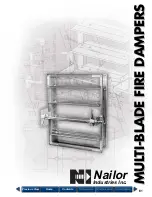
18.
18 Removing/replacing or repositioning the FSD-TD actuator -
Fig. 1
18.1 Ensure that the power has been isolated from the actuator and that the damper is now in the failsafe
position, this would normally be with the blades in the closed position.
18.2 Using the 8mm spanner, undo the centre-bolt anti-clockwise and remove along with the washer keeping
safe and close to hand.
18.3 Lift the actuator and cradle and place in a safe secure place within the limitations of the attached wiring.
Ensure that the actuator is not supported/left hanging solely by the connected wiring.
18.4 For repositioning the actuator, tum cradle through 90° to the desired position and then relocate actuator,
pointer, washer 8mm A/F screw into position and tighten to 5Nm max torque.
19.
Routine Inspection. Testing and Maintenance
19.1 In accordance with BS 9999 Annex W.1, inspection should be undertake annually. Local
regulations/conditions may override this with periodic Inspection being carried out more frequently
where corrosive or dirty conditions prevail. The maintenance log should be reviewed at each
inspection and the frequency adjusted as required dependent upon findings. (BSB recommend a
maximum of 1 year between inspections and to start more frequently initially and reduce
frequencies only if conditions are proven to allow).
19.2 For actuators fitted with a thermal fuse), check TF is correctly fitted to duct. (Refer to section 15)
19.3 Where a thermal fuse is present, the LED on the thermal fuse will be illuminated when the actuator
is powered. Refer to Section 20.1, if it is not illuminated.
19.4 Remove access door to reveal damper's internal elements.
19.5 Visually inspect the internal damper elements for signs of corrosion, obstruction or accumulated
dirt/dust.
19.6 If there are any obstructions or if the damper's blades/gasket seals are dirty, they need to be
cleaned. It is recommended to remove the actuator before cleaning the internal elements to avoid
trapping your fingers. (Refer to section 20)
19.7 Visually check that the damper is in its 'powered state' (opposite to fail-safe position). If the damper
is not in its 'powered state', refer to fault finding chart, otherwise continue.
19.8 Temporarily remove electrical power to the actuator (either by using the test switch on the thermal
fuse (TF actuator), or by isolating power to actuators without a thermal fuse).
19.9 The actuator should reach its SPRING-END (fail-safe position) in <30 seconds. Confirm visually
that the blade position and indication pointer on the actuator corresponds.
19.10 Release the TF test switch (TF) and ensure it reaches its DRIVE END in <60 seconds. Confirm
visually that blade position and indication pointer on the actuator corresponds.
19.11 If the damper has seized (failing to reach either drive end or spring end):-
19.11.1 Isolate and remove actuator.
19.11.2 Spray a light lubricant into blade end bearings through the holes on the side
gaskets.
19.11.3 Using the 12mm A/F spanner on the TD box Drive Shaft, begin to progressively
operate the blades manually.
Page 16
FSD-TD - Installation Operation and Maintenance Instructions























